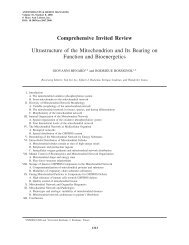MiPsummer Programme pdf - Mitochondrial Physiology Society
MiPsummer Programme pdf - Mitochondrial Physiology Society
MiPsummer Programme pdf - Mitochondrial Physiology Society
Create successful ePaper yourself
Turn your PDF publications into a flip-book with our unique Google optimized e-Paper software.
79<br />
Abstract # 47<br />
Insulin sensitivity does not correlate with mitochondrial respiration: Studies in gastric bypass<br />
patients<br />
Lund M.T 1, 2 , M. Hansen 1 , A. Floyd 2 , K. Bech 2 , Helge J 1 . W, F. Dela 1 .<br />
1 Biomedical Sciences, University of Copenhagen, 2 Department of Surgery, Koege Hospital,<br />
Denmark.<br />
Introduction and aim<br />
Obesity and type 2 diabetes are accompanied<br />
by intramyocellular lipid accumulation. It has<br />
been hypothesized that this leads to<br />
mitochondrial dysfunction and insulin<br />
resistance. Our aim was to compare changes in<br />
peripheral insulin sensitivity and<br />
mitochondrial respiration after a diet induced<br />
weight loss and subsequently by a Roux-En-Y<br />
gastric bypass induced weight loss in obese<br />
patients with or without type 2 diabetes (T2D).<br />
Materials and methods:<br />
16 subjects (4M/12F; 6 with (T2DM) and 10 (OB) without T2D) reported thrice to the lab after an<br />
overnight fast: Prior to weight loss (A), 2 mo later just prior to operation (B) and 4 mo after<br />
operation (C). At each visit tree tests were performed: Day 1: DEXA scan for body composition and<br />
a graded bicycle test for VO 2 max. Day 2: Hyperinsulinaemic euglycemic clamp to measure<br />
peripheral insulin sensitivity. A biopsy was taken from m. vastus lateralis for respirometry prior to<br />
the clamp. Muscle fibers were split, permeabilised and transferred to the respirometer.<br />
Results:<br />
Anthropometric data is shown in the table.<br />
Insulin sensitivity measured per fat free mass<br />
(GIR/FFM) and maximally coupled respiration<br />
data are shown in the figure.<br />
Conclusion:<br />
In spite of the marked difference in insulin<br />
sensitivity between OB and T2DM, maximally<br />
coupled mito-chondrial respiration was similar in<br />
the two groups. Moreover, with marked<br />
improvements in T2DM insulin sensitivity, due<br />
to the massive weight loss, mitochondrial<br />
respiration remained unchanged. These results<br />
speak against an association of mitochondrial<br />
respiratory capacity and insulin resistance in<br />
skeletal muscle in OB and T2DM.



